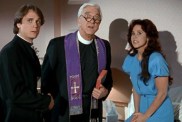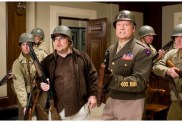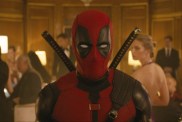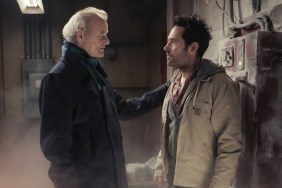Greetings and welcome back to the Weekend Warrior, your weekly guide to the weekend’s new movies. Tune in every Tuesday for the latest look at the upcoming weekend, and then check back on Thursday night for final projections based on actual theatre counts.
If you aren’t doing so already, you can follow The Weekend Warrior on Twitter where he talks about box office, movies, music, comic books and all sorts of random things.
1. Resident Evil: Afterlife (Sony/Screen Gems) – $28.4 million N/A
2. The American (Focus Features) – $6.5 million -51%
3. Takers (Screen Gems) – $5.7 million -48%
4. Machete (20th Century Fox) – $5.1 million -55%
5. Going the Distance (New Line/WB) – $3.7 million -47%
6. The Expendables (Lionsgate) – $3.6 million -46%
7. The Last Exorcism (Lionsgate) – $3.3 million -55%
8. The Other Guys (Sony) – $3.0 million -44%
9. Eat Pray Love (Sony) – $2.7 million -43%
10. Inception (Warner Bros.) – $2.6 million -41%
Weekend Overview
With the fall season kicking off for reals, things will slow down a bit as we start getting more dramas and arthouse fare hoping for awards recognition at year’s end. The first weekend after Labor Day tends to be a dead zone since everyone is returning to school and work after their summer vacations and putting the nose to the grindstone is more important than going to see what generally are considered weaker movie fare.
At least that would normally be the plan if not for the release of Resident Evil: Afterlife (Sony/Screen Gems). Director Paul W.S. Anderson is back for the fourth installment with his beautiful wife Milla Jovovich back in the role of Alice, and this time around the movie has been shot in glorious 3D and will be released both in 3D and IMAX 3D theaters, which certainly should help bring in those who may have tired of the franchise, as will the return of Anderson to the director’s chair. With no other new releases and many of the summer movies tailing off, it stands a good chance that “Afterlife” will surpass the opening weekends of both its predecessors and be another strong September opener for Screen Gems. Considering how poorly some of the returning movies have fared, it could end up grossing as much as the rest of the Top 10 combined with more than half that roster being in the $2 to 4 million range.
In honor of the release of Resident Evil: Afterlife in IMAX, we’re having a special…
RESIDENT EVIL IMAX CONTEST!
The IMAX Corporation has graciously supplied us with some cool prizes and one Grand Prize winner will receive:
(1) Resident Evil DVD Trilogy
(1) Resident Evil IMAX 3D Poster
(1) 4-pack of IMAX tickets (so you can take three friends with you to see the movie in IMAX)
For five runner-ups, we’ll provide a pair of IMAX tickets.
All you have to do is Email me at warrior AT comingsoon DOT net by Thursday morning at 9AM Eastern with your address and the answers to these three questions and we’ll pick a winner at random:
1. What is the original name for the “Resident Evil” game in Japan?
2. Which character from the movies has never been playable in any of the games despite being introduced both in the first movie and the first game?
3. Who was the narrator for the original “Resident Evil” film?
Not that it might help you answering the questions, but you can find trailers, photos and full coverage for Resident Evil: Afterlife over on ShockTillYouDrop.com.
This weekend last year, the inimitable Tyler Perry returned with the adaptation of his early play I Can Do Bad All By Myself (Lionsgate), starring Taraji P. Henson, which opened with $23.5 million, not his strongest opening by any means, but not bad for this generally slow weekend. The animated 9 (Focus Features), directed by Shane Acker and produced by Tim Burton and Timur Bekmambetov, opened on Wednesday 9/9/09 with $3.1 million and then took second place for the weekend with $10.7 million. The two horror movies of the weekend Sorority Row (Summit) and the long-delayed Whiteout (Warner Bros.) both bombed with roughly $5 million each for sixth and seventh place, respectively. The Top 10 grossed $71.5 million last year, and this weekend may be have trouble making that amount unless “Resident Evil” or some of the returning movies fare better than expected.
THE BATTLE CRY
Since this may be the last “Battle Cry” for some time due to upcoming September commitments, I wanted to talk about one of the vaguer aspects of the film industry that may seem simple and transparent at first, but once you really start to think about it, it’s an incredibly fascinating and complex factor in every film release from the biggest studio blockbusters to the smallest arthouse fare. It’s called “marketing” and it seemed like it deserves closer study than just being mentioned in passing when talking about movies.
Granted, I’m not any sort of expert on marketing, and most of my thoughts on it are from the point of view of an outsider, someone who watches and studies the campaigns to see what works and what doesn’t, but also someone who is somewhat tapped into how people react to trailers, commercials that play a part in the best and worst campaigns. Being that I don’t have any sort of degree or experience in marketing myself–other than the odd quote I may provide to use in a studio’s campaign–I asked a friend of mine who has a great deal of experience working on a lot of good movies, more than a few great movies, and yeah, a few stinkers as well. I learned some interesting things about the behind-the-scenes of marketing, which unfortunately, I can’t share directly, though it was very informative for sure.
On the surface, marketing is about creating awareness for a movie, but it’s also the way a studio sell its wares to the masses and tries to convince them to see their movie over others. It’s not just about saying “Hey, here’s a movie with such-and-such actor doing something you may want to see,” it’s about convincing moviegoers that this movie is the most important must-see event of the coming weekend. It’s about taking whatever the studio thought would make the movie a marketable commodity and put it out there in a way that convinces moviegoers that this is the movie they have to see. Marketing almost always involves spending a good deal of money, though spending a lot of money doesn’t always guarantee it will pay off. Universal did a fine job making sure everyone was aware of Edgar Wright’s Scott Pilgrim vs. the World before it opened last month, but it failed to make the movie look like anything anyone but diehard fans of Wright or the source material might want to see. Apparently, that’s one of the biggest obstacles facing studio marketing departments, when raised awareness increases the lack of interest at the same time.
Either way, it’s something very much in the public consciousness right now, because it’s becoming more and more begrudgingly referred to as “false advertising” especially this past week with the success of George Clooney’s The American. That was a great example of how a marketing campaign can turn a movie that might normally get a limited arthouse release into a bonafide hit, though the movie’s success is somewhat bittersweet, not because it was necessarily a bad movie, but because it’s just not the movie that’s being advertised.
When critics were finally given a chance to see the movie last Monday, two days before it opened, it immediately got out that it was a slow artfully-made film about an assassin trying to retire, not the action-packed “Bourne”-like movie being advertised. It owed more to artier Clooney-Soderbergh collaborations like Solaris and The Good German than to the movies it was being made to look like. Whether it was the last-minute nature of the reviews or the fact moviegoers were already convinced this was something they wanted to see, the movie won the Labor Day weekend, defeating two movies that would seem like stronger fare among mass audiences for a holiday weekend.
And yet, going to Twitter tells a different story. Here are some examples of the reactions we found to the movie:
“Just saw The American – the worst movie ever made. Avoid it at all costs.”
“Just waisted (sic) $20 watching The American.”
“The American. Wtf was that movie?!?”
“Just saw The American with George Clooney. What a bullsh*t movie. So slow. And I’m a Clooney fan.”
Wow, that’s pretty bad, right? And that is the norm.
Even so, the movie opened better than Clooney’s Michael Clayton, a movie that was almost universally-praised by critics and ended up being nominated for many well-deserved Oscars, despite being declared the death of Clooney’s career by the press when it opened with just $10.3 million. (It ended up grossing roughly $50 million so clearly word-of-mouth did what marketing couldn’t.)
Lionsgate’s marketing for The Last Exorcism–probably the least expensive wide releases of the summer–helped push that movie over the top with moviegoers, and that was an even more difficult campaign, because at first, they were hiding the fact the movie was told in a faux documentary style (similar to Paranormal Activity) and then realized seemingly at the last minute that was what set it apart from similar movies. By the time people went to see it, they were expecting one thing or another, but everyone was expecting a movie full of scares and none of the social commentary and humor.
Marketing plays a large part in two things we’ve discussed a lot in this column: whether moviegoers should trust critics and reviews, and what happens when studios decide not to screen movies at all, instead letting their marketing campaigns do all the talking when convincing moviegoers to see their movies. It’s somewhat of a double-edged sword, because the studios who don’t screen movies for critics still will often use endorsing “pull quotes” as part of their campaigns. Having such strong trailers can sometimes hurt movies with critics, too. For instance, by the time they got to see The American, two days before opening, there was no way to avoid the stylish posters and action-packed commercials; while some embraced the movie for the artfilm it was, others were just annoyed at being fooled themselves.
But does that make marketing a bad thing? Not really, because you have to remember that first and foremost, the movie business is a business, and when studios are spending millions of dollars for filmmakers and actors to explore their artistic side, it’s paramount for them to do whatever it takes to make that money back. Sure, moviegoers will get pissed and they’ll bad mouth a movie on Twitter–which was the case with both movies mentioned–but will they remember being cheated out of their money the next time a movie comes around that looks good to them that may not be? Probably not, because this has been going on from the dawn of the movie industry, and it will continue to happen as long as studios take chances with the movies they fund and feel there’s a way that they can keep from losing money on those movies.
One has to expect that smarter moviegoers will eventually figure it out, although the adage about “fooling some of the people some of the time, not fooling all the people all the time,” has been disproven countless times by successful marketing campaigns for some truly awful movies. Then again, when a movie like The American ends up receiving absolutely abysmal CinemaScores of D–even worse than The Last Exorcism‘s D a week earlier–it’s obvious moviegoers aren’t being given what they’re paying for and they’re not happy about it. And given the poor economy and how expensive the moviegoing experience is these days, that can’t bode well for continued box office success for weaker movies.
Analysis:
There was a time during the ’90s when video games became one of the primary sources for movie adaptations, and one of the filmmakers at the forefront of this was Paul W.S. Anderson who had a solid hit with his movie based on Mortal Kombat in 1995, which led to him taking on a number of other video game adaptations. When his fourth movie Resident Evil opened in the March of 2002 it didn’t really make waves, opening with $17 million and grossing less than $40 million, but it did enough business on DVD to lead to two more successful sequels, which each ended up with $50 million. Since the movies were making money, it was decided to do a fourth movie and Anderson decided to return to the director’s chair with the added incentive that Resident Evil: Afterlife would be his first movie filmed entirely using James Cameron’s 3D team.
So far, Milla Jovovich’s biggest hit to date has been her debut in former husband Luc Besson’s The Fifth Element right around the time when Anderson was starting to find an audience with his genre flicks, and she continues to bring guys in with the “Resident Evil” movies even if her other vehicles like Ultraviolet haven’t found nearly as much success. Last year, she appeared in the long-delayed David Twohy thriller A Perfect Getaway followed by The Fourth Kind, the latter doing significantly better but still not achieving the success of the “Resident Evil” movies.
Returning from the previous movie is Ali Larter as Claire Redfield, as well as British actress Sienna Guillory’s Jill Valentine, who we haven’t seen since the second movie. In the fourth movie, we’ll also finally meet meet Claire’s brother Chris, played by Wentworth Miller, who appeared in the debut of another popular Screen Gems franchise, Underworld. Anderson’s return to the directing chair was a smart move though, because he’s a popular filmmaker among genre fans, having had big hits with Mortal Kombat and Alien vs. Predator as well as movies that have done well on DVD like Resident Evil and Death Race.
Even so, the biggest factor in the fourth movie’s success will probably be that it’s opening in IMAX and 3D theaters. This isn’t the hokey trend of converting movies to 3D ala The Last Airbender, but the film was actually shot in full 3D using James Cameron’s team, which is something that’s being heavily promoted. Resident Evil: Afterlife isn’t the first franchise to go 3D for its fourth installment, as it’s following in the footsteps of The Final Destination, which opened with nearly three times as much as the original movie to became the highest-grossing movie in the series thanks to the higher price of 3D tickets. If Resident Evil: Afterlife is hugely successful, then it won’t exactly be setting a precedent, but it will give studios a good reason to justify spending the money to make their sequels in 3D. It’s true that there is somewhat of a 3D backlash going on, but “Afterlife” was always planned as a 3D movie, something known to its fans.
The second movie Resident Evil: Apocalypse made $9.3 million its opening day and its sequel made a little more than that its opening day, but one assumes that with the additional price for 3D and IMAX tickets, Afterlife should be able to open bigger. Although it’s opening in one of the worst possible weekends, a time frame when kids are returning to school and people are trying to get back to work after their summer relaxation, it’s also the only new movie choice opening after a couple of slow weekends where even “anticipated” movies like Piranha and Machete underdelivered. With many college students returning to school, the movie could be seen as one thing to do as a group over the weekend and there should be enough interest among the fanbase that they’ll try to go out Thursday or Friday to see the movie, and it benefits greatly from opening without any competition whatsoever, either in terms of new or returning movies. (In this case, the 3D might play a big factor since once would probably need one of those fancy and expensive 3D televisions in order to wait until DVD and watch the movie in its intended format.)
Each of the three movies have generally been received the same whether by critics who hated all three movies– the original movie’s 34% rating on Rotten Tomatoes was better than the sequels, which ended up in the 21-22% range–or by fans who rated all three movies roughly in the same range on IMDb. Reviews won’t matter much, because the movie won’t be screened for real critics. Why should they? The movie is marketed and sold entirely on its visuals and action, and it already has a built-in fanbase, similar to the “Underworld” movies, and with few other strong choices for those who’ve already seen Machete and the like, the fourth installment should take full advantage of the lack of strong movies in theaters.
Why I Should See It: The video games are pretty kick-ass and the fourth movie certainly has potential with all of the characters from the games in one place, not to mention the return of Anderson and it being filmed in 3D.
Why Not: The previous three movies have been flawed and can this one avoid the fourth film curse?
Projections: $28 to 30 million opening weekend and roughly $70 million total.
THE CHOSEN TWO:
Since this is a light week for new wide releases, I’m recommending two new movies opening in New York.

A few years back, John Scheinfeld’s doc The U.S. vs. John Lennon took an in-depth look at the problems the late Beatles founder had when settling in New York during the ’70s, and this follow-up is another terrific documentary about one of Lennon’s best friends and biggest influences, singer/songwriter Harry Nilsson.
Personally, I remember when I was younger and had a number of musician friends who were absolutely nuts about Nillson, though even with my love for all kinds of music, I never quite understood the appeal. As I’ve gotten older, I’ve grown to understand and appreciate Nilsson’s work but frankly, it’s almost impossible not to come away from Scheinfeld’s moving doc feeling somewhat enlightened, because it does a lot more than just create a profile of the singer, but it really gets into his mindset as it covers his early career as a songwriter to creating his own identity and career to winning a Grammy for “Nilson Schmilsson.” Being a studio musician who never did live shows except for carefully choreographed television performances greatly added to the mystery behind the man, which is one reason why this movie is so immediately intriguing and even the most diehard fan may be surprised by some of the film’s revelations.
Nilsson’s story is told through a combination of interviews with Nilsson’s closest friends and business partners, former wives and kids as well as a self-made audio tape made by Nilsson late in his life that acts as an autobiographical memoir of some of the different aspects of his life. Hearing Nilsson’s voice recount some of the incidents firsthand is as haunting as hearing Cobain’s voice narrate A.J. Schnack’s Kurt Cobain: About a Son.
Right off the bat, you’re informed by many people what a gorgeous singing voice Nillson had; movie fans will may know that voice from the theme for Midnight Cowboy or the song Nilsson did for Terry Gilliam’s The Fisher King – the last recording of his life. Many of the interview subjects also mention what a crazy party animal Nilsson was, especially later in his career. Everyone has great stories to share about their friend and colleague, and they’re all quite honest about his idiosyncrasies as well, especially his musical collaborators who fondly remember the making of classic records and opine how short-lived that relationship was.
Nillson clearly had a huge influence on many of his peers, not only from the likes of the Beatles but also on other studio pioneers like Brian Wilson. Hearing great songwriters like Randy Newman and Van Dyke Parks and Jimmy Webb and Paul Williams talking about their peer with such reverence is another clear indication of why he was so important. The movie also gets heavily into his private life and how the divorce from his first wife adversely affected his work and his ability to keep things together. Toward the end, the movie starts to get dark as Nilsson’s partying starts to overtake his creativity, and later in life, Nilsson gets political, fighting for gun control after the murder of his friend John Lennon.
Sure, there’s sometimes a danger of the movie turning into the type of talking heads doc that’s hard to keep the viewer interested, but we hear so many great anecdotes from those who really knew Nilsson that you can’t help walking away from the movie wanting to study and explore his music more fully. Anyone who appreciates the art of songwriting or making music will want to know more about this musical pioneer, and Scheinfeld’s engrossing doc is the perfect introduction to his legacy, as well as one of the better music docs you’re likely to see this or any year.
Who is Harry Nilsson (and Why is Everybody Talkin’ About Him?) opens at the Cinema Village in New York on Friday.

Exclusive Clip and Interview with Director Pascal Chaumeil and Romain Duris
As someone who has regularly trashed American romantic comedies for being too predictable and formulaic, it’s nice to know the French still know how to make classy comedies that are every bit as funny and entertaining as their American counterparts. Heartbreaker was one of the standouts at this year’s Tribeca Film Festival, a real crowd-pleaser with audiences there. Though the trailer makes it look just like an American romantic comedy with lots of dumb physical comedy, there’s a lot more going on in this movie which revolves around one of the strongest high concept premises we’ve seen this year. Heartbreaker is very much one of those movies that’s infinitely funnier and deeper than it may look.
Much of what makes this movie work so well is the casting of Romain Duris, one of France’s finest actors for many years, but here playing a role that allows him to tap into something we haven’t seen from him since L’Auberge Espagnole and its sequel. Duris is Alex, the charmer at the forefront of an operation that convinces unhappy women to break up with their significant others, doing whatever is necessary to have success. We’re given a good taste of this operation with an opening that shows Alex going through one of his seductions. Like secret agents, Alex and his team prepare for each job by finding out everything they can about their target and then infiltrating their lives, using that information to help the women warm up to Alex’s charms. Although they’ve been doing this for some time, Alex needs money to pay off a loan shark, so they take on a difficult job from a billionaire who wants to stop his daughter from getting married, so Alex poses as her bodyguard and begins the process for seducing her.
Despite the high concept of professional heartbreakers, the movie does start out like any other “meet cute” romantic comedy with Juliette not wanting anything to do with her new bodyguard, but once Alex turns on the charm, it’s quite amusing how zany things get. Just as you’re getting used to their awkward chemistry, a spanner is thrown into the works in the form of Juliette’s college friend Sophie, a drunken nymphomaniac who wants to put the moves on Alex herself, and the humor factor is immediately raised by Helena Noguerra’s hilarious performance. Then there’s Alex’s partners in “crime,” played by Julie Ferrier and François Damiens, who have their own very funny subplots as they try to keep things interesting for themselves as Alex does much of the heavy lifting.
Vanessa Paradis is incredibly sexy and alluring, and the pairing of her with Duris is perfection; you can easily believe she’d be able to crack through his façade and that he’d start developing feelings for her in the line of duty. As soon as it’s mentioned that Juliette loves the classic ’80s dance movie Dirty Dancing, you kind of know where it’s heading, but just because it’s predictable doesn’t make it any less enjoyable.
Watching Duris doing all sorts of crazy things is partially why the movie’s so captivating, since many are so used to him playing things very serious, and when he says he’ll do anything to win women over and convince them he’s a better man then the one they have isn’t just talk, and in this case, we see him doing all sorts of crazy things from singing gospel to jumping on the hood of cars. Some of the funniest moments are when the tears start to well up in Alex’s eyes to try to win sympathy from his “victims.”
What really sets the movie apart from many other French comedies is the way Chaumeil directs the material as a fast-moving poppy film that rarely lets up, the soundtrack consisting of head-bopping funky instrumentals used to similar effect as Soderbergh did with Ocean’s 11.
There’s plenty of beautiful arty movies coming from France, but sometimes you just want to go to the movies to laugh and have a good time, maybe enjoy a bit of romance. Heartbreaker offers all of that, and when it comes to combining romance, comedy and action, you really can’t beat how well those elements are integrated into this delightful hidden gem.
It’s undoubtedly true that many women who see this movie will instantly fall for Duris–life imitates art after all–and the movie certainly has the potential to really break him out in the States. Sadly, being a French film and a very different movie from what IFC normally releases, it may be tough for them to find the sort of audience that Heartbreaker deserves.
Regardless, it opens in select cities including the IFC Center in New York on Friday, and if you’re looking for a fun date movie this weekend, we highly recommend it.
Also in Limited Release:
Galt Niederhofer adapts her own book The Romantics (Paramount Famous) with an ensemble cast including Katie Holmes, Anna Paquin, Malin Ackerman, Josh Duhamel and Elijah Wood, as a group of friends reuniting for one of their weddings, and a lot of secrets coming out as they get more and more drunk. Having debuted at this year’s Sundance Film Festival, it opens in select cities on Friday.
Mini-Review: (Coming Soon!)
Francois Ozon’s Hideaway (Strand Releasing) stars Isabelle Carré as a woman who gets pregnant from her junkie boyfriend (Melvil Poupaud) and decides to keep the baby, hiding out in the country with her boyfriend’s gay brother Paul (Louis-Ronan Choisy) as she tries to clean up and an unusual relationship develops. It opens in New York at
Mini-Review: (Coming Soon!)
Professional wrestler John Cena and Devon Graye from “Dexter” star in Mel Damski and John Posey’s wrestling-based drama Legendary (Samuel Goldwyn Films) as two estranged brothers, the latter taking up wrestling in hopes of reuniting them with their mother, played by Patricia Clarkson, after the death of their father. It opens in select cities on Friday.
Mini-Review: (Coming Soon!)
Andrew Gurland and Huck Botko, writers of The Last Exorcism, write and direct The Virginity Hit (Sony), a DIY comedy involving four guys on a quest to get one of their friends laid and capture the event on camera. It opens in select cities on Friday, mainly college towns, and then expands into other cities on September 17 and 24.
Casey Affleck’s faux (?) documentary I’m Still Here: The Lost Year of Joaquin Phoenix (Magnolia) follows his brother-in-law Joaquin Phoenix in the spring of 2009 when the actor decided to give up his craft to become a rapper. It opens on Friday in select cities following its screening at the Toronto International Film Festival.
Nik Fakler’s romantic drama Lovely, Still (Monterey Media) stars Martin Landau as a lonely older man who arrives home on Christmas to find a stranger (Ellen Burstyn) standing in his house, which ultimately leads to a romantic love affair. It opens at the Cinema Village in New York on Friday and then expands to other theaters in the coming weeks. You can see the full release schedule here.
Rachel Perkins’ Australian musical romantic comedy hit Bran Nue Dae (Freestyle Releasing) starring Geoffrey Rush is about the romance between a young aboriginal couple set against the Australian landscape. It opens in New York at the Village East Cinemas.
Ahead of Time (Vitagraph Films) is Robert Richman’s documentary about Ruth Gruber, the 97-year-old woman who became the first journalist to enter the Soviet Arctic in 1937 on a secret mission for the Roosevelt Administration, as well as covering the Middle East in the ’40s. It opens in New York on Friday and in L.A. on September 24.
Michele Hozer and Peter Raymont’s doc Genius Within: The Inner Life of Glenn Gould (Lorber Films) takes a look at the classical pianist through archival footage, focusing both on his personal demons and his musical gift. It opens in New York at the Lincoln Plaza and Quad Cinema.
Alexei Kaleina and Craig Macneill’s drama The Afterlight (Studio) is about a young couple (Michael Kelly, Jicky Schnee) trying to start a new life by moving into an old schoolhouse on the edge of a farm and when an eclipse approaches, their arrival sets off a series of events and starts the deterioration of their relationship. Also starring Rip Torn, it opens at the Quad Cinema in New York for one week only.
Also at New York’s IFC Center on Friday, porn star and “Entourage” guest star Sasha Grey presents Frankie Latina’s Modus Operandi, starring Danny “Machete” Trejo, a thriller involving two mysterious briefcases and the factions trying to get their hands on the contents. There are also two new docs opening, Jorge W. Atalla’s Sequestro (Kidnapped) about the efforts of São Paulo Brazil’s Anti-Kidnapping Division to put an end to the city’s growing kidnapping business, and Vicki Abeles’ Race to Nowhere about the cheating that has become commonplace in schools, causing stress and depression in students who are unprepared for college and the workplace.
Next week, there are four new movies with Emma Stone starring in the comedy Easy A (Sony/Screen Gems), Ben Affleck’s sophomore directing effort The Town (Warner Bros.) co-starring Jeremy Renner, the elevator-based horror thriller Devil (Rogue Pictures) and the computer animated adventure Alpha and Omega (Lionsgate).
Since we’ll be busy at the Toronto International Film Festival, one can expect it to be a minimal column and probably a day or two late. But follow our coverage here and on Twitter.
Copyright 2010 Edward Douglas
Read more at https://www.comingsoon.net/weekend-warrior/news/69543-the-weekend-warrior-september-10-12#HX7GId4Bzg9MbObu.99









